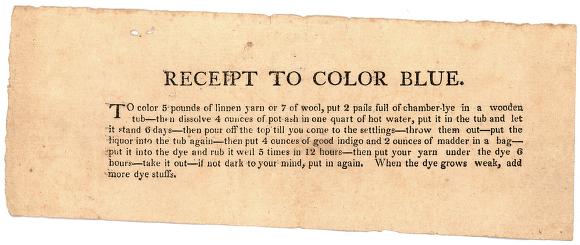




Advanced Search
| Online Collection |
|
|||||||||||||||||||||
|
Before there were commercially available dyes, people who sought to dye cloth resorted to elaborate recipes to create dyes at home. Here, two different highly alkaline chemicals, lye (potassium hydroxide) and pot ash (potassium carbonate) were combined with two dyes, indigo and madder. Lye was derived by leaching wood ashes to create a liquid; pot ash by leaching the ashes of vegetables to create a white powder. Both were extremely caustic and were used as detergents. The form of lye specified here, chamber-lye, was created by adding lye to urine, a natural form of ammonia. They are used here to create a liquid that penetrated the fabric's threads and bonded the dye to them. Added to that mix was indigo, a blue dye derived from the plant of the same name; indigo was the original dye of "blue jeans." Finally, madder was added. Madder comes from the root of the plant Rubica tinctorum, which produces reddish to blueish dyes.
|
"Receipt To Color Blue"
|
| |
Home | Online Collection | Things
To Do | Turns
Exhibit | Classroom | Chronologies | My
Collection
About This Site | Site Index | Site Search | Feedback


